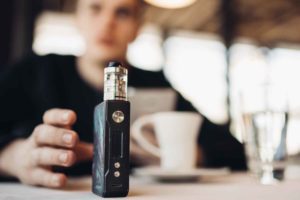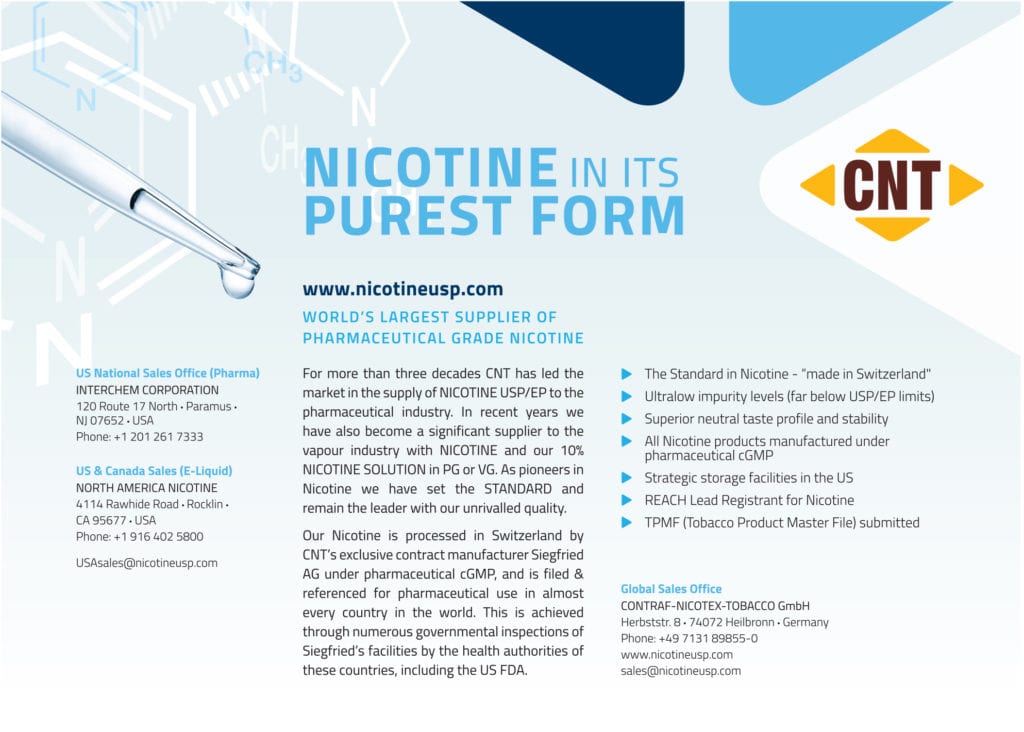
Using medical licensing to get smokers to switch to vaping products is like using a hammer to crack a nut.
By George Gay
On the face of it, the U.K.’s big tobacco/nicotine news story of 2021 was the announcement that e-cigarettes and other inhaled nicotine-containing products could in the future be prescribed through the National Health Service (NHS) in England. Of course, the problem with “could” stories is that they come pre-loaded with “might not” stories. And there is the nagging concern, also, that this story is not quite as new as it seems. But let’s start on a positive note.
An Oct. 29 press note issued by the peculiarly named Department of Health and Social Care and Office for Health Improvement and Disparities said the Medicines and Healthcare products Regulatory Agency (MHRA) had published updated guidance paving the way for medicinally licensed e-cigarettes to be prescribed for tobacco smokers who wished to quit smoking. The health and social care secretary, Sajid Javid, was quoted as saying that opening the door to a [sic] licensed e-cigarette prescribed on the NHS had the potential to tackle the stark disparities in smoking rates across the country, helping people to stop smoking wherever they lived and whatever their background.
“Manufacturers can approach the MHRA to submit their products to go through the same regulatory approvals process as other medicines available on the health service,” the story said. “This could mean England becomes the first country in the world to prescribe e-cigarettes licensed as a medical product. If a product receives MHRA approval, clinicians could then decide on a case-by-case basis whether it would be appropriate to prescribe an e-cigarette to NHS patients to help them quit smoking.”
In fact, this statement was qualified by a background note saying e-cigarettes could be prescribed only after the National Institute for Health and Care Excellence (NICE) had recommended them for use. It did not spell out the circumstances under which NICE might recommend or reject such prescribing, but it is likely that one possible case for rejection would be a poor cost/benefit ratio.
Nevertheless, the announcement was generally well received. Philip Morris International said in a note published on its website that it supported the U.K. government’s plan to simplify the pathway to license electronic cigarettes and other inhaled nicotine-containing products as medicines in England.
At the same time, John Dunne, director-general of the U.K. Vaping Industry Association, said in a press note the government deserved “huge praise for taking this bold decision to look more closely at the use of vaping when it comes to smoking cessation and for taking an evidence-based, science-led approach rather than the nonsensical anti-vaping, anti-harm reduction stance of some countries.”
Meanwhile, Doug Mutter, director of VPZ, which recently launched a vape clinic service across its retail network of 157 U.K. stores, said in a press note that he believed vaping products being prescribed through the NHS in England could provide a huge leap forward in the country’s ambitions to be smoke-free by 2030. “We fully welcome the news that the NHS in England is exploring opportunities to prescribe vaping products to help people quit smoking,” he said. But he added that he believed it was not simply about prescribing a vape product and smokers going away and quitting smoking. “People need education, expert knowledge, support, advice and a personalized service that meets their individual needs,” he said. “Our vape clinic service responds to this demand and is filling a huge void left by [cuts to NHS] stop-smoking services…”
This need for consumer support had echoes in a new nationwide initiative launched at the end of October and aimed at providing guidance to frontline nursing staff at U.K. hospitals. The initiative, which was being rolled out to every NHS trust by the U.K. Vaping Industry Association and the stop-smoking app, Smoke Free, provides access to a range of resources that provide healthcare practitioners with the knowledge needed for them to give sound advice on how to switch from conventional cigarettes to vape products. It follows a decision by the NHS earlier this year to trial the use of vapes in selected hospitals.
Qualified support
A number of health professionals working in tobacco control also welcomed the government announcement, but many qualified their support. Probably, the most common concern was that, because the process of obtaining a medicines license, even if simplified, would still be complex and expensive, only tobacco companies would be able to attempt it.
There were basically two strands to this concern. One was that some healthcare professionals found the involvement of tobacco companies distasteful, tout court, while another was that consumers might be encouraged to try only licensed, tobacco-company products when other, unlicensed but more efficacious products were available.
This second argument is interesting partly because it raises the question of how much importance would consumers attach to a medicines license. After all, few smokers in the U.K. today started their habit at a time when the risks of smoking were unknown, so we can assume they are not severely risk averse.
Given this, I think it would be reasonable to assume that not all of those who tell researchers they are looking to quit smoking want to do so for health reasons. Additionally, the question raised about the importance smokers attach to health concerns is underlined in the U.K. because switching from smoking to vaping stalled some time ago even though Public Health England (an executive agency of the Department of Health and Social Care whose health protection and health improvement responsibilities were split between two other bodies at the start of October 2021) was on record as saying vaping is probably 95 percent less risky than smoking.
And despite PMI’s positive reaction, it cannot be assumed that all tobacco companies would want to go down the medicines license route. I cannot help thinking, for instance, that it would be something of a disadvantage in getting a product tied to a medicines license because, I assume, it would become petrified within an overall market that was dynamic. Unless the process of obtaining and holding a medicines license for vaping products in the U.K. is to be changed substantially, even obtaining permission to change the font size on the packaging would entail an involved process.
At least, this is what I was told while previously writing a few stories on Voke, which was or is a product developed over 12 years by Kind Consumer and licensed by the MHRA as a medicinal product that was a safer alternative to combustible cigarettes. Voke was not a vaping product but an alternative nicotine-delivery system that used pharmaceutical-standard inhaler technology in a device closely resembling a traditional cigarette in both the way it looked and in the way a consumer, in using the device, mimicked most of the rituals of smoking. Voke, which had no batteries and no electronics and therefore generated no heat and no chemical reactions and produced neither smoke nor vapor, just an invisible, cool, odorless aerosol, could be used anywhere. And its environmental credentials were good given that it was a relatively simple device made of metal, card and plastic: materials that can be recycled.
And yet, despite its medicines license and all the other apparent advantages it offered, it didn’t take off. It is worth noting, however, that British American Tobacco, which had cooperated with Kind in developing Voke, pulled out of the arrangement before the product was launched. It is worth noting, too, that Voke was launched as a consumer product in normal retail outlets, not in pharmacies, and not much seemed to be made of its having a medicines license. Finally, its much-delayed launch was not helped by coinciding with the arrival of the coronavirus pandemic.
Beyond the soundbites
I don’t want to be too downbeat, but it has to be said that the e-cigarettes announcement was made by a government better at sound bites than policy. The reference by Javid to tackling “the stark disparities in smoking rates across the country” would have been meant to have fed into government claims to be intent on levelling up the country, a strategy being honored more in the breach than the observance. Whether the policy announcement will survive mixing with the realities of an NHS struggling from the effects of more than 10 years of austerity and those of the Covid-19 pandemic remains to be seen.
In this regard, it was interesting that one healthcare professional who welcomed the announcement as “excellent news” went on to say one of the reasons why one in three U.K. smokers had not tried e-cigarettes was because of the perceived cost barrier. Having approved devices prescribed would therefore help those least able to afford e-cigarettes.
This raises some interesting questions, not least of which is whether the government has thought through the costs involved if e-cigarette prescriptions started to be given out liberally. And even if it has, has it decided whether ex-smokers should be allowed e-cigarettes on prescription for the rest of their lives rather as a diabetic is provided with insulin for life?
If you follow the logic of most thinking on nicotine addiction, you would have to say that cutting off prescriptions for e-cigarettes at some time in the future would lead only to relapse. Another question is whether the government could hold the line if, after prescribing came in, young, nonsmokers started to cut out the middleman and take up vaping in numbers, as seems possible.
The question has to be faced, also, as to whether general practitioners would be happy to prescribe e-cigarettes. The first step in encouraging them to do so would be convincing many of them that nicotine in the doses delivered by e-cigarettes was not harmful. But even so, there is the question of whether in asking them to do so you would be causing them to be conflicted.

The obvious answer to this is that healthcare professionals are generally accepting of the concept of harm reduction, but for some I’m sure there would be a difference between giving to heroin addicts clean needles from a medical supplies company and providing smokers with e-cigarettes from a tobacco company. Such conflicts have surely been reflected in the labored approach the U.S. Food and Drug Administration has taken since being saddled with overseeing a harmful product.
A simpler solution
To my way of thinking, one of the best comments on the government announcement came as part of a quote on the Science Media website by Peter Hajek, director of the Tobacco Dependence Research Unit at the Queen Mary University of London, who admitted to being ambivalent about the plan. Hajek welcomed the fact that the initiative provided a positive message that e-cigarettes were much less risky than smoking and helped smokers quit.
“Overall, it would seem easier to just recommend existing products, which are well regulated by consumer protection regulations,” he said. “There is sufficient evidence available now that these products are effective and dramatically reduce the risks of smoking.”
I’m not sure what Hajek meant by “recommend,” but all the government needs to do to promote the shift from smoking to vaping is to allow manufacturers of e-cigarettes complying with consumer protection regulations to state on packaging and advertising agreed wording to the effect outlined by Hajek: “these products are effective and dramatically reduce the risks of smoking.”
It seems to me that, as things stand, using medicines licensing to try to shift smokers from cigarettes to vaping products is like taking a hammer to crack a nut because I’m not convinced the changes made by the MHRA to its guidance for licensing e-cigarettes as medicines would produce the results sought.
I was told the key changes made relate to guidance on the quality standards for dose uniformity, nonclinical toxicological data requirements and the design of the clinical pharmacokinetic studies. The updates were said also to reflect changes to the regulatory environment post-Brexit.
John Britton, emeritus professor of epidemiology at the University of Nottingham, in generally welcoming the government announcement, made the point on Science Media that what was needed urgently was a bespoke regulatory system for all nicotine products that allowed market access and endorsement by health professionals in inverse proportion to those products’ health hazards.
This, to my mind, is correct. The question remains, however, just how bespoke the system needs to be to work. I’m not convinced the changes announced will be enough. In fact, I’m not convinced any bespoke system complying with the necessarily rigorous demands of the MHRA would give rise to a workable system. I hope I’m wrong.


